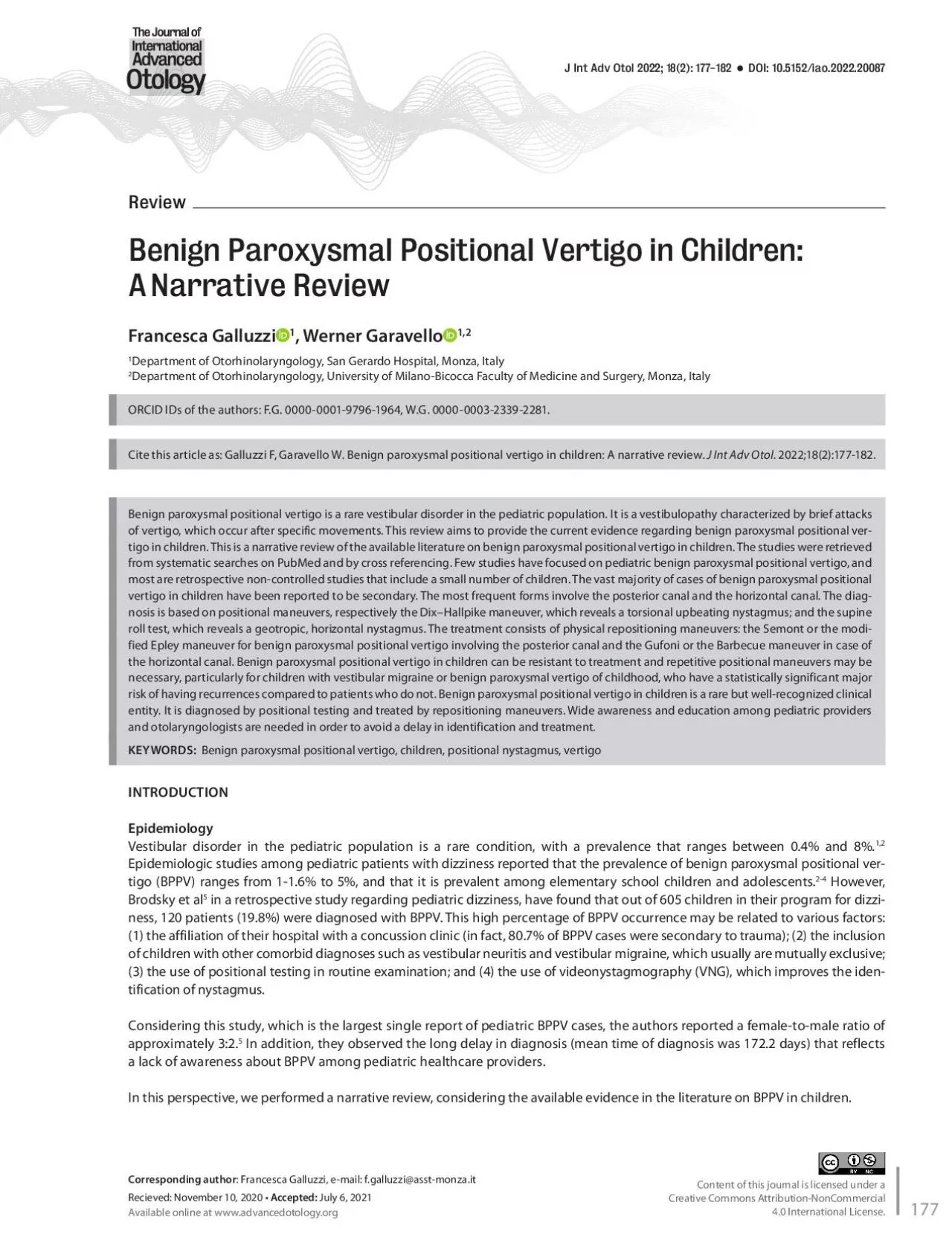

177 Werner Garavello Department of Otorhinolaryngology San Gerardo Hospital Monza ItalyDepartment of Otorhinolaryngology University of MilanoBicocca Faculty of Medicine and Surgery Monza Ital ID: 938130
Download Pdf The PPT/PDF document "Benign Paroxysmal Positional Vertigo in ..." is the property of its rightful owner. Permission is granted to download and print the materials on this web site for personal, non-commercial use only, and to display it on your personal computer provided you do not modify the materials and that you retain all copyright notices contained in the materials. By downloading content from our website, you accept the terms of this agreement.
177 Benign Paroxysmal Positional Vertigo in Children: A Narrative ReviewFrancesca Galluzzi , Werner Garavello Department of Otorhinolaryngology, San Gerardo Hospital, Monza, ItalyDepartment of Otorhinolaryngology, University of Milano-Bicocca Faculty of Medicine and Surgery, Monza, ItalyORCID IDs of the authors: F.G. 0000-0001-9796-1964, W.G. 0000-0003-2339-2281.Cite this article as: Galluzzi F, Garavello W. Benign paroxysmal positional vertigo in children: A narrative review. J Int Adv Otol. 2022;18(2):177-182.Benign paroxysmal positional vertigo is a rare vestibular disorder in the pediatric population. It is a vestibulopathy characterized by brief attacks of vertigo, which occur after specific movements. This revie
w aims to provide the current evidence regarding benign paroxysmal positional vertigo in children. This is a narrative review of the available literature on benign paroxysmal positional vertigo in children. The studies were retrieved from systematic searches on PubMed and by cross referencing. Few studies have focused on pediatric benign paroxysmal positional vertigo, and most are retrospective non-controlled studies that include a small number of children. The vast majority of cases of benign paroxysmal positional vertigo in children have been reported to be secondary. The most frequent forms involve the posterior canal and the horizontal canal. The diagnosis is based on positional maneuvers, respectively the Dix–Ha
llpike maneuver, which reveals a torsional upbeating nystagmus; and the supine roll test, which reveals a geotropic, horizontal nystagmus. The treatment consists of physical repositioning maneuvers: the Semont or the modified Epley maneuver for benign paroxysmal positional vertigo involving the posterior canal and the Gufoni or the Barbecue maneuver in case of the horizontal canal. Benign paroxysmal positional vertigo in children can be resistant to treatment and repetitive positional maneuvers may be necessary, particularly for children with vestibular migraine or benign paroxysmal vertigo of childhood, who have a statistically significant major risk of having recurrences compared to patients who do not. Benign paroxysma
l positional vertigo in children is a rare but well-recognized clinical entity. It is diagnosed by positional testing and treated by repositioning maneuvers. Wide awareness and education among pediatric providers and otolaryngologists are needed in order to avoid a delay in identification and treatment.KEYWORDS: Benign paroxysmal positional vertigo, children, positional nystagmus, vertigoINTRODUCTIONVestibular disorder in the pediatric population is a rare condition, with a prevalence that ranges between 0.4% and 8%.Epidemiologic studies among pediatric patients with dizziness reported that the prevalence of benign paroxysmal positional vertigo (BPPV) ranges from 1-1.6% to 5%, and that it is prevalent among elementary sc
hool children and adolescents. However, Brodsky et al in a retrospective study regarding pediatric dizziness, have found that out of 605 children in their program for dizziness, 120 patients (19.8%) were diagnosed with BPPV. This high percentage of BPPV occurrence may be related to various factors: (1) the affiliation of their hospital with a concussion clinic (in fact, 80.7% of BPPV cases were secondary to trauma); (2) the inclusion of children with other comorbid diagnoses such as vestibular neuritis and vestibular migraine, which usually are mutually exclusive; (3) the use of positional testing in routine examination; and (4) the use of videonystagmography (VNG), which improves the identification of nystagmus.C
onsidering this study, which is the largest single report of pediatric BPPV cases, the authors reported a female-to-male ratio of approximately 3:2. In addition, they observed the long delay in diagnosis (mean time of diagnosis was 172.2 days) that reflects a lack of awareness about BPPV among pediatric healthcare providers.In this perspective, we performed a narrative review, considering the available evidence in the literature on BPPV in children. Galluzzi and Garavello.BPPV is a Rare Treatable Cause of Vertigo in Children Corresponding author: Francesca Galluzzi, e-mail: f.galluzzi@asst-monza.itRecieved: November 10, 2020 • Accepted:Available online at www.advancedotology.org 218 J Int Adv Otol 2022; 18(2): 177-18